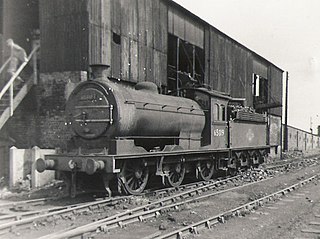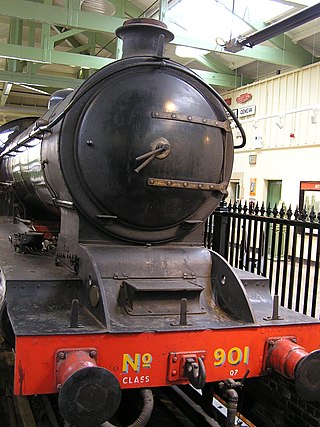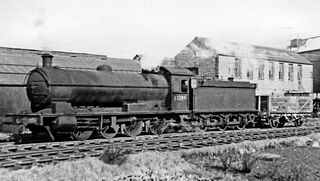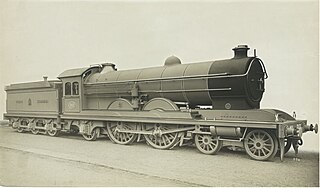
The North Eastern Railway (NER) was an English railway company. It was incorporated in 1854 by the combination of several existing railway companies. Later, it was amalgamated with other railways to form the London and North Eastern Railway at the Grouping in 1923. Its main line survives to the present day as part of the East Coast Main Line between London and Edinburgh.
The London and North Eastern Railway (LNER) produced several classes of locomotive, mostly to the designs of Nigel Gresley, characterised by a three-cylinder layout with a parallel boiler and round-topped firebox. It produced the most famous locomotive of its day, 4468 'Mallard', the holder of the world steam locomotive speed record. It also built the world-famous 4472 'Flying Scotsman'. However, its locomotive inheritance was much greater than just the 'A4 Class', it also produced highly successful mixed-traffic and freight designs.

The North Eastern Railway (NER) Class P3, classified J27 by the LNER, is a class of 0-6-0 steam locomotive. The P3 Class was designed by Wilson Worsdell and was a relatively minor modification of the existing North Eastern Railway Class P2. The most significant change was a deeper firebox with shallower sloping fire grate. This was achieved by raising the boiler slightly, and by reducing the clearance between the firebox and the rear axle. The P3 Class were a freight engine by nature and used for hauling long trains of freight.

The North Eastern Railway Class T3, classified as Class Q7 by the LNER, is a class of 0-8-0 steam locomotive designed for heavy freight. Five were built by the NER in 1919 and a further 10 by the London and North Eastern Railway (LNER) in 1924.

The North Eastern Railway Class T2, classified as Class Q6 by the LNER, is a class of 0-8-0 steam locomotive designed for heavy freight, especially for hauling long coal trains to various collieries in the North Eastern region of the UK, with a maximum speed of 40 miles per hour. 120 were built at Darlington Works and Armstrong Whitworth between 1913 and 1921 to the design of Vincent Raven, based on the NER Class T and T1. The batch of fifty built by Armstrong Whitworth from 1919 were A-W's first locomotives to be built, after the conversion of their Scotswood works from ordnance to peacetime production.

The North Eastern Railway Class S3, classified B16 by the LNER, was a class of 4-6-0 steam locomotive designed for mixed traffic work. It was designed by Vincent Raven and introduced in 1920. The earlier members of this class were fitted with Westinghouse Brakes - all of this equipment was removed during the 1930s.

Gateshead TMD was a railway traction maintenance depot situated in Gateshead, England. The depot code was 52A during the steam era and GD later on.

The North Eastern Railway (NER) Class H, classified as Class Y7 by the London and North Eastern Railway (LNER) is a class of 0-4-0T steam locomotives designed for shunting.

The North Eastern Railway Class E1, classified as Class J72 by the London and North Eastern Railway (LNER), is a class of small 0-6-0T steam locomotives designed by Wilson Worsdell for shunting. They had inside cylinders and Stephenson valve gear.

The first London and North Eastern Railway (LNER) Class A2 was a class of 4-6-2 steam locomotive designed by Vincent Raven for the North Eastern Railway. Two were built by the NER in 1922 before the grouping and another three by the LNER in 1924. Their LNER numbers were 2400–2404. All five locomotives were named by the LNER.

Hopetown Carriage Works, also known as the Stockton and Darlington Railway Carriage Works, was a carriage works of the Stockton and Darlington Railway built in 1853 in Hopetown, near Darlington, County Durham, England.

The NER 901 Class was a class of 2-4-0 steam locomotive of the North Eastern Railway, designed by Edward Fletcher. Between 1872 and 1882 55 of the class were built for the NER.
The North Eastern Locomotive Preservation Group (NELPG) was formed in 1966 with the intention of preserving some of the steam locomotives then still working on regular goods or passenger trains in North East England. At the time of its formation, its first president was Wilbert Awdry, the author of The Railway Series books and the creator of Thomas the Tank Engine. Now the group owns four unique North Eastern steam locomotives, its aim is to have as many of its steam locomotives running on the main line or preserved lines as possible. In 2014, the LNER K1 (62005) ran on the North Yorkshire Moors Railway and on the Jacobite service in Scotland. The LNER Q6 was undergoing boiler repairs at the start of the season but finished the season on the North Yorkshire Moors Railway and the LNER J72 ran on the Wensleydale Railway. The group have two workshops, one at Hopetown Carriage Works, Darlington and another workshop and base at Grosmont, the northernmost station on the North Yorkshire Moors Railway. The shed at Grosmont is called deviation shed. Members of the group hold regular evening meetings to discuss railway subjects, have a membership newsletter, and have produced various publications. The group now also has a junior volunteers section, training young recruits at, mainly, the NYMR and Deviation Shed. These JVs will help with mainly the locomotives, although a small amount has been done on the carriages.
William Bouch was an English railway engineer, who is famous for the steam locomotives he designed for the Stockton and Darlington Railway.
West Auckland railway station served the villages of St Helen Auckland and West Auckland in County Durham, England, between 1833 and 1962. It was on the railway line between Bishop Auckland and Barnard Castle. There was a locomotive depot, which was the only one to be both closed completely and later reopened by the London and North Eastern Railway.
The North Eastern Railway was formed by merger in 1854 and merged into the London and North Eastern Railway at the grouping in 1923. Between those dates five men held the post of Locomotive Superintendent.

Tees Marshalling Yard is a railway marshalling yard, used to separate railway wagons, located near Middlesbrough in North Yorkshire, Northern England.

The NER Class R1 was a class of 4-4-0 steam locomotives of the North Eastern Railway. The class was designed by Wilson Worsdell and built from 1908 to 1909.

The Darlington and Barnard Castle Railway, was an east–west railway line that connected Darlington and Barnard Castle in County Durham, England. Besides the main running line, it had two branches that headed south into Yorkshire that were only used for freight. The whole system opened up by July 1856 and was closed completely by 1966. The former Merrybent freight branch is now used as part of the A1(M) road that bypasses to the west of Darlington.

The NER Class Z was an Atlantic class of locomotives designed by Vincent Raven. It was introduced in 1911.



















